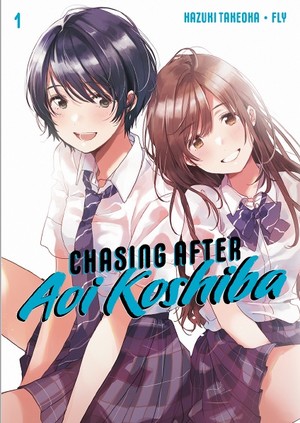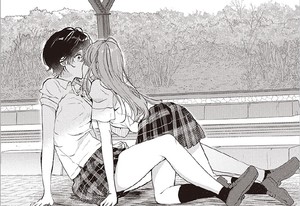The Spring 2021 Manga Guide
Chasing After Aoi Koshiba
What's It About?
 Sahoko had lots of friends in high school, so there's no shortage of people to catch up with at her reunion. But the one face she wants to see is missing: that of Aoi Koshiba, her classmate and first love. A star of the basketball team, Aoi caught Sahoko's eye as an easy way to score social points. But when Aoi quits the team, an unexpected kiss pulls Sahoko closer to her than she intended to be. With a difficult home situation, Aoi is in need of more than just a cynical social climber. She needs a true friend, and something more…
Sahoko had lots of friends in high school, so there's no shortage of people to catch up with at her reunion. But the one face she wants to see is missing: that of Aoi Koshiba, her classmate and first love. A star of the basketball team, Aoi caught Sahoko's eye as an easy way to score social points. But when Aoi quits the team, an unexpected kiss pulls Sahoko closer to her than she intended to be. With a difficult home situation, Aoi is in need of more than just a cynical social climber. She needs a true friend, and something more…Chasing After Aoi Koshiba is scripted by Hazuki Takeoka and illustrated by FLY and Kodansha Comics has released its first volume both digitally and in print for $7.99 and $12.99 respectively.
Is It Worth Reading?

Rebecca Silverman
Rating:
I've been a dedicated fan of Fly's work since Éclair Blanc, where their entry was a beautiful, bittersweet piece that accomplished more with no words than some stories do with thousands. Chasing After Aoi Koshiba, although written by someone else, does nothing to change my mind. The story – which follows Sahoko in her crush on Aoi Koshiba, another girl at her high school – relies on both a framing device of a four-year school reunion and on Sahoko's uncertainty about just what it is she feels for Aoi; both of those plot points require an art style heavy on the speaking glances, body language, and quiet moments of emotional turmoil. Fly is certainly up for all of that, and in fact that's what made that short story I mentioned such a successful piece.
Fortunately, the story itself is also worth paying attention to, because no amount of beautiful art can save a poorly put-together plot. What's interesting about it is that the romance itself is oddly uncertain about whether or not there's a romance happening. Sahoko, who is our point of view character for most of the book, doesn't know why she's so drawn to Aoi Koshiba in the first place. She knows that Aoi was on the basketball team in middle school but stopped playing in high school and she's aware that Aoi now mostly hangs out with boys rather than other girls, but in a one-of-the-guys kind of way. These things fascinate her, and while at first she just thinks (or tells herself) that Aoi would elevate her Instagram game, it's clear that there's more going on. Sahoko has consciously remade herself from an angler fish into a dolphin, but that strange dark-dwelling form is still inside of her, and she has to be very aware of how it struggles to escape. Aoi, she thinks, has the sort of easy flair that she lacks.
For her part, Aoi is miffed by Sahoko's attention, even more so when Sahoko chases her down and suddenly kisses her. She doesn't appear put off by the other girl, but to Aoi, Sahoko's the one with all of the gifts. She's pretty, popular, and able to do whatever she wants, unlike Aoi, who has some restrictions on her life that most people aren't aware of. Even Aoi joining the Home Ec Club is motivated by something beyond an interest in crafts, and it almost feels as if she's testing Sahoko to see if she deserves to know.
Do they like each other? Are they simply envious of each other? The frame story indicates that even years later, they're not sure, and that they may never really know. But even if there's no happy ending for these two, their story has enough pull to make it worth finding out for sure.
Lynzee Loveridge
Rating:
How do you write a story that keeps readers coming back when it stars a wholly unlikable protagonist? That's Chasing After Aoi Koshiba's biggest hurdle and the element that's likely to be most divisive for readers. The story follows Sahoko, a girl that has firmly established herself as an “it girl” of her grade after previously spending most of her school life as a nobody. Now, the whole concept of a “high school debut” is prominent in shojo stories. The trope posits that high school is a time to reinvent yourself and adjust your appearance, clubs, and life in order to get some social status. This can vary from a wallflower exiting puberty to be a gorgeous, well-liked classmate to what we have with Sahoko: a self-absorbed girl obsessed with appearances and honing in on the flaws of others.
I've read other stories featuring female characters putting on a facade and anxiously trying to avoid anyone discovering who they really are at home or who they used to be in middle school in fear that their carefully constructed persona will come crashing down. Usually those characters are still good people, even if their outward self is a shallow defense mechanism. I wouldn't, at least not right now, categorize Sahoko as a “good” person, even putting aside her frivolousness. She's opportunistic, having integrated herself with two girls because of social perceptions. There's no reason she shouldn't be friends with Anna, for instance, but it calls into question if she really knows her or likes her outside of what she offers Sahoko socially.
She approaches her other classmates similarly, comparing them to “background characters” which is a term that carries some (perhaps unintended) baggage thanks to online trolls. She sums up two girls in the Home Ec. Club as “the creepy one that resembles a Kokkuri doll” and “the girl with an extra 2.2lbs.” That's the only outright example of body-shaming by Sahoko, but readers will also notice that she has some signs of disordered eating, too.
Honestly, I found Sahoko both casually hateful and obnoxious. I got a level of enjoyment out of her inability to pin down Aoi, a girl who is just wholly genuine in a way that fascinates Sahoko. There are tinges of romance developing, almost entirely on Sahoko's side, but the manga also gives us glimpses of the future where the two aren't in contact and have drifted apart like most high school acquaintances. Maybe Sahoko is better now, but the question is whether you want to see the other characters walk her through not being an asshole.
discuss this in the forum (52 posts) |
this article has been modified since it was originally posted; see change history
back to The Spring 2021 Manga Guide
Feature homepage / archives